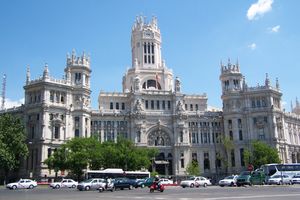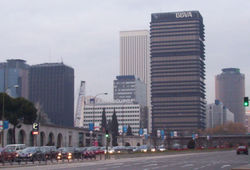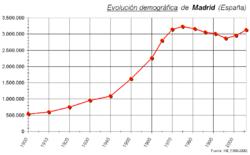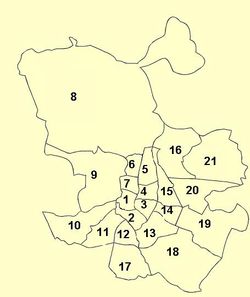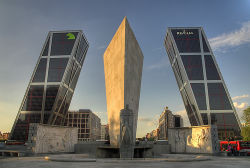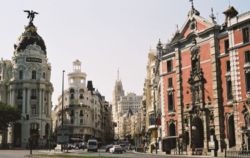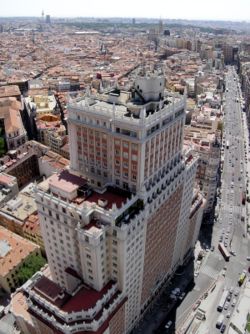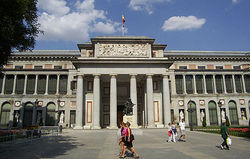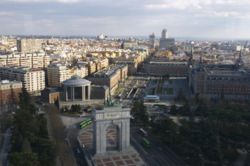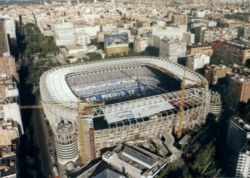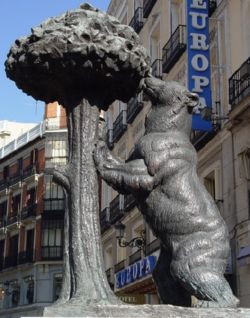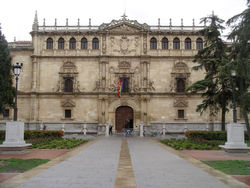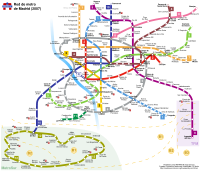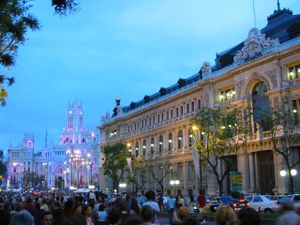Madrid
2007 Schools Wikipedia Selection. Related subjects: European Geography
| Villa de Madrid | |||||
|
|||||
| Location | |||||
|---|---|---|---|---|---|
| Coordinates : 40° 23’N , 3°43′0″W Time Zone : CET (GMT +1) - summer: CEST (GMT +2) |
|||||
| General information | |||||
| Native name | Villa de Madrid (Spanish) | ||||
| Spanish name | Villa de Madrid | ||||
| Founded | 9th century | ||||
| Postal code | 28001-28080 | ||||
| Area code | 34 (Spain) + 91 (Villa de Madrid) | ||||
| Website | http://www.munimadrid.es/ | ||||
| Administration | |||||
| Country | Spain | ||||
| Autonomous Community | Comunidad Autónoma de Madrid | ||||
| Province | Madrid | ||||
| Administrative Divisions | 21 | ||||
| Neighborhoods | 127 | ||||
| Mayor | Alberto Ruiz-Gallardón ( PP) | ||||
| Geography | |||||
| Land Area | 607 km² | ||||
| Altitude | 667 m AMSL | ||||
| Population | |||||
| Population | 3,228,359 (2005) | ||||
| - rank in Spain: | 1st | ||||
| Density | 5,198 hab./km² (2005) | ||||
Madrid is the capital of Spain and the third most populous city in the European Union. Madrid is also the largest city in Spain, as well as in the province and the autonomous community of the same name. It is located on the river Manzanares in the centre of the country, between the autonomous communities of Castilla-León and Castilla-La Mancha. Due to its geographical location, wealth and history, Madrid is considered one of the financial centers of the Iberian Peninsula, together with Lisbon, and the political centre of Spain.
As the capital of the Spanish Empire, Madrid is a city of great cultural and political importance. While Madrid possesses a modern infrastructure, it has preserved the look and feel of many of its historic neighborhoods and streets. Its landmarks include the huge Royal Palace of Madrid; a restored 1850 opera house; the Buen Retiro park, opened in 1631; the imposing 19th-century building containing the Spanish National Library (founded 1712); the national archives; an archaeological museum of international reputation; and three superb art museums: Prado Museum, which houses one of the finest art collections in the world, the Museo Nacional Centro de Arte Reina Sofía, a museum of modern art, and the Thyssen-Bornemisza Museum, housed in the renovated Villahermosa Palace.
The population of the city was 3.5 million (December 2005), while the estimated urban area population is 5.5 million. The entire population of the Madrid metropolitan area (urban area and suburbs) is calculated to be 5.84 million. The city spans a total of 607 km² (234 square miles).
Following the restoration of democracy in 1975 and Spain's integration into the European Union, Madrid has played an increasing role in European finances, marking the city as one of the most important European metropolises. The residents of Madrid are called Madrileños, and the current mayor is Alberto Ruiz-Gallardón, of the centre-right Partido Popular.
See Wiktionary for the name of Madrid in various languages other than English and Spanish.
Names of the city and origin of the current name
There are numerous theories regarding the origin of the name, "Madrid". Madrid was founded by Ocno Bianor (son of King Tirenio of Tuscany and Mantua) and was named "Metragirta" or "Mantua Carpetana". Others contend that the original name of the city was "Ursa" ("bear" in Latin), due to the high number of these animals that were found in the adjacent forests, which, together with the Madrone tree ("madroño" in Spanish), have been the emblem of the city from the Middle Ages. Nevertherless, it is now commonly believed that the origin of the current name of the city comes from the 2nd Century B.C., when the Roman Empire established a settlement on the banks of the Manzanares river. The name of this first village was "Matrice" (a reference to the river that crossed the settlement). Following the invasions of the Sueves, Vandals and Alans during the 5th Century A.D., the Roman Empire could not defend its territories on the Iberian Peninsula, and were therefore overrun by the Visigoths. The barbarian tribes subsequently took control of "Matrice". In the 7th Century the Islamic conquest of the Iberian Peninsula saw the name changed to "Mayrit", from the Arabic term "Mayra" (referencing water as a "mother" or "source of life") and the Ibero-Roman suffix "it" that means "place". The modern "Madrid" evolved from the Mozarabic "Matrit", which is still in the Madrilenian gentilic.
History
Middle Ages
Although the site of modern-day Madrid has been occupied since pre-historic times, in Roman age his territory belonged to the diocese of Complutum (present Alcalá de Henares). But the first historical data on the city comes from the 9th century, when Muhammad I ordered the construction of a small palace in the same place that is today occupied by the Palacio Real. Around this palace a small citadel, al-Mudaina, was built. Near that palace was the Manzanares, which the Muslims called al-Majrīṭ (Arabic: المجريط, "source of water"). From this came the naming of the site as Majerit, which was later rendered to the modern-day spelling of Madrid). The citadel was conquered in 1085 by Alfonso VI of Castile in his advance towards Toledo. He reconsecrated the mosque as the church of the Virgin of Almudena (almudin, the garrison's granary). In 1329, the Cortes Generales first assembled in the city to advise Ferdinand IV of Castile. Sephardi Jews and Moors continued to live in the city until they were expelled at the end of the 15th century. After troubles and a large fire, Henry III of Castile ( 1379- 1406) rebuilt the city and established himself safely fortified outside its walls in El Pardo. The grand entry of Ferdinand and Isabella to Madrid heralded the end of strife between Castile and Aragon.
Renaissance
The kingdoms of Castilla, with its capital at Toledo, and Aragón, with its capital at Zaragoza, were welded into modern Spain by Charles I of Spain. Though Charles favored Madrid, it was his son, Philip II ( 1527- 1598) who moved the court to Madrid in 1561. Although he made no official declaration, the seat of the court was the de facto capital. Sevilla continued to control the Spanish Indies, but Madrid controlled Sevilla. Aside from a brief period, 1601-1606, when Felipe III installed his court in Valladolid, Madrid's fortunes have closely mirrored those of Spain. During the Siglo de Oro (Golden Century), in the 16th/17th century, Madrid had no resemblance with other European capitals: the population of the city was economically dependent on the business of the court itself.
End of Renaissance and early modern Madrid
Felipe V decided that a European capital could not stay in such a state, and new palaces (including the Palacio Real de Madrid) were built during his reign. However, it would not be until Carlos III ( 1716- 1788) that Madrid would become a modern city. Carlos III was one of the most popular kings in the history of Madrid, and the saying "the best mayor, the king" became popular during those times. When Carlos IV ( 1748- 1819) became king the people of Madrid revolted. After the Mutiny of Aranjuez, which was led by his own son Fernando VII against him, Carlos IV resigned, but Fernando VII's reign would be short: in May of 1808 Napoleon's troops entered the city. On May 2, 1808 (Spanish: Dos de Mayo) the Madrileños revolted against the French forces, whose brute reaction would have a lasting impact on French rule in Spain and France's image in Europe in general.
After the war of independence ( 1814) Fernando VII came back to the throne, but after a liberal military revolution, Colonel Riego made the king swear respect to the Constitution. This would start a period where liberal and conservative government alternated, that would end with the enthronement of Isabel II ( 1830- 1904).
The 20th century in Madrid
Isabel II could not calm down the political tension that would lead to yet another revolt, the First Spanish Republic, and the comeback of the monarchs, which eventually led to the Second Spanish Republic and the Spanish Civil War. During this war ( 1936- 1939) Madrid was one of the most affected cities and its streets were battlezones. Madrid was a stronghold of the Republicans from July 1936. Its western suburbs were the scene of an all out battle in November 1936, when the Nationalist forces tried to take the city. Thereafter, the city was besieged for almost three years, until it surrendered in March 1939. It was during the Civil War that Madrid became the first city to be bombed by airplanes specifically targeting civilians. (See Siege of Madrid (1936-39)).
During the dictatorship of Francisco Franco, especially after the sixties, the south of Madrid became very industrialized and there were massive migrations from rural environments into the city. Madrid's south-eastern periphery became an extensive slum settlement, which was the base for an active cultural and political frame.
After the death of Franco, emerging democratic parties (including those of left-wing and republican ideology) accepted Franco's wishes of being succeeded by Juan Carlos I - in order to secure stability and democracy - which led Spain to its current position as constitutional monarchy.
Befitting from the prosperity it gained in the 1980s, the capital city of Spain has consolidated its position as the leading economic, cultural, industrial, educational, and technological centre on the Iberian peninsula.
21st century
On 11 March 2004, Madrid was hit by a terrorist attack when terrorists placed a series of bombs on multiple trains during the rush hour, three days before the 14 March 2004 elections. This was the worst massacre in Spain since the end of the civil war in 1939.
Europride 2007 ( July 1) will be hosted by Madrid, Spain.
Madrid has also expressed its desire to become an Olympic city, and became a candidate for the 2012 games, which were awarded to London after Madrid was eliminated in the third round of the ballot. However, the mayor of the city has already stated that Madrid's Olympic dream did not end at Singapore, as the city will again present itself as a candidate to host the 2016 Olympic games.
Economy and demographics
Economy
The village experienced a big development as a consequence of the establishment of the new capital of the Spanish Empire in Madrid. The administrative functions that it held since then, as well as the centralist character of the government found by the house of Bourbon ("Casa de Borbón" in Spanish) triggered the development of the artisan activity, that turned into industrial since the middle of the 19th century, having its major expansion during the 20th century, especially after the Spanish Civil War. The economy of the city was then centered on diverse sectors such as those related to motor vehicles, aircraft, chemicals, pharmaceuticals, processed food, printed materials, and leather goods. Besides its many manufacturing industries. Two facts contributed to this industrial development: the encouragement given by the government and the fact of being the capital city of the country, which made the city the main communications centre, banking headquarters, etc. Despite of the current tendency of moving the production centers to industrial parks located in the outskirts of the metropolitan area, the city of Madrid still is the second most important industrial centre in the country, only exceeded by Barcelona. During the last few years, Madrid has experienced a very significant growth in its tertiary activities. Then, to the traditional administrative functions (Madrid houses the central Administration of the State) and financial (Madrid is the headquarter of a high amount of companies that execute their activities all over the country and that receives half of the whole national financial capital) now we can also add others such us: the ring structure of the roads and trains system and the significance of the Barajas Airport. Moreover, Madrid is also developing a new series of activities with a touristic, ludic and cultural character. The appointment of Madrid as European City of Culture in 1992 was a very important milestone in this process, encourages both by public and private iniciatives.
Demographics
| Evolution 1897 - 2005 | |||
|---|---|---|---|
| Year | Total municipality |
Total province |
Percent (%) |
| 1897 | 542.739 | 730.807 | 74,27 |
| 1900 | 575.675 | 773.011 | 74,47 |
| 1910 | 614.322 | 831.254 | 73,90 |
| 1920 | 823.711 | 1.048.908 | 78,53 |
| 1930 | 1.041.767 | 1.290.445 | 80,73 |
| 1940 | 1.322.835 | 1.574.134 | 84,04 |
| 1950 | 1.553.338 | 1.823.418 | 85,19 |
| 1960 | 2.177.123 | 2.510.217 | 86,73 |
| 1965 | 2.793.510 | 3.278.068 | 85,22 |
| 1970 | 3.120.941 | 3.761.348 | 82,97 |
| 1975 | 3.228.057 | 4.319.904 | 74,73 |
| 1981 | 3.158.818 | 4.686.895 | 67,40 |
| 1986 | 3.058.812 | 4.780.572 | 63,98 |
| 1991 | 3.010.492 | 4.647.555 | 64,78 |
| 1996 | 2.866.850 | 5.022.289 | 57,08 |
| 2001 | 2.938.723 | 5.423.384 | 54,19 |
| 2004 | 3.099.834 | 5.804.829 | 53,40 |
| 2005 | 3.155.359 | 5.964.143 | 52,90 |
The population of Madrid has experienced increase ever since the city became the national capital. This demographic boom was notorious in the 20th century due to domestic and international immigration. However, the city experienced a growth slump during the 1970s. This phenomenon, which also affected Barcelona, was caused mainly by the growth of satellite suburbs at the expense of the downtown.
A new immigration wave has allowed Madrid not only to recover its old numbers, but to reach new historical heights. According to census data, the population of the city grew by 271,856 between 2001 and 2005.
As the capital city of Spain, the city has attracted many immigrants from around the world. While less than 85% of the inhabitants are Spaniards of different backgrounds and ethnicities (almost 90% of the native Spaniards are caucasians), there are many recent immigrants who come from Latin America, Europe, Asia, North Africa and West Africa.
The largest immigrant groups include: Ecuadorian: 83,967, Moroccan: 51,300, Chinese: 48,973, Colombian: 37,218 and Peruvian: 32,791. There are also important communities of Guinean, Romanian and Filipino people.
Names
The natives of the city are called Madrileños; they were once nicknamed gatos (cats), although nowadays the vast majority of Spaniards would not recognize the term. Its origin possibly comes from the popular legend that the conquest of the city by Alfonso VI was achieved by the assault of the walls that protected the city. Apparently the Castilian troops climbed the defense walls as if they were cats. Another possible source of the name is the fact that the residents were known during the Middle Ages for their ability to climb walls with their bare hands.
Climate
The region of Madrid has a Mediterranean climate with cold winters that experience temperatures lower than 0 °C. Summer tends to be warm with temperatures that consistently surpass 30 °C in July and that can often reach 40 °C. Due to Madrid's high altitude and dry climate, nightly temperatures tend to be cooler, leading to a lower average in the summer months. Precipitation levels are low, but precipitation can be observed all throughout the year. Summer and winter are the driest seasons, with most rainfall occurring in the autumn and spring.
| 1971-2000 | Jan | Feb | Mar | Apr | May | June | July | Ago | Sep | Oct | Nov | Dec | Total |
|---|---|---|---|---|---|---|---|---|---|---|---|---|---|
| Maximum temperature (ºC) |
9,7 | 12,0 | 15,7 | 17,5 | 21,4 | 26,9 | 31,2 | 30,7 | 26,0 | 19,0 | 13,4 | 10,1 | 19,4 |
| Minimum temperature (ºC) |
2,6 | 3,7 | 5,6 | 7,2 | 10,7 | 15,1 | 18,4 | 18,2 | 15,0 | 10,2 | 6,0 | 3,8 | 9,7 |
| Rainfall (mm) | 37 | 35 | 26 | 47 | 52 | 25 | 15 | 10 | 28 | 49 | 56 | 56 | 436 |
| 1971-2000 | Jan | Feb | Mar | Apr | May | June | July | Ago | Sep | Oct | Nov | Dec | Total |
|---|---|---|---|---|---|---|---|---|---|---|---|---|---|
| Maximum temperature (ºC) |
10,6 | 12,9 | 16,3 | 18,0 | 22,3 | 28,2 | 33,0 | 32,4 | 27,6 | 20,6 | 14,7 | 11,0 | 20,6 |
| Minimum temperature (ºC) |
0,3 | 1,5 | 3,2 | 5,4 | 8,8 | 13,0 | 16,1 | 16,0 | 12,7 | 8,3 | 3,8 | 1,8 | 7,6 |
| Rainfall (mm) | 33 | 34 | 23 | 39 | 47 | 26 | 11 | 12 | 24 | 39 | 48 | 48 | 386 |
Administrative divisions
Districts
Madrid is administratively divided into twenty-one districts, that, at the same time, are divided into different neighborhoods (barrios):
- Centro: Palacio, Embajadores, Cortes, Justicia, Universidad, Sol.
- Arganzuela: Paseo Imperial, Acacias, Chopera, Legazpi, Delicias, Palos de Moguer, Atocha.
- Retiro: Pacífico, Adelfas, Estrella, Ibiza, Jerónimos, Niño Jesús.
- Salamanca: Recoletos, Goya, Fuente del Berro, Guindalera, Lista, Castellana.
- Chamartín: El Viso, Prosperidad, Ciudad Jardín, Hispanoamérica, Nueva España, Pza. Castilla.
- Tetuán: Bellas Vistas, Cuatro Caminos, Castillejos, Almenara, Valdeacederas, Berruguete.
- Chamberí: Gaztambide, Arapiles, Trafalgar, Almagro, Vallehermoso, Ríos Rosas.
- Fuencarral-El Pardo: El Pardo, Fuentelarreina, Peñagrande, Barrio del Pilar, La Paz, Valverde, Mirasierra, El Goloso.
- Moncloa-Aravaca: Casa de Campo, Argüelles, Ciudad Universitaria, Valdezarza, Valdemarín, El Plantío, Aravaca.
- Latina: Los Cármenes, Puerta del Ángel, Lucero, Aluche, Las Águilas, Campamento, Cuatro Vientos.
- Carabanchel: Comillas, Opañel, San Isidro, Vista Alegre, Puerta Bonita, Buenavista, Abrantes.
- Usera: Orcasitas, Orcasur, San Fermín, Almendrales, Moscardó, Zofio, Pradolongo.
- Puente de Vallecas: Entrevías, San Diego, Palomeras Bajas, Palomeras Sureste, Portazgo, Numancia.
- Moratalaz: Pavones, Horcajo, Marroquina, Media Legua, Fontarrón, Vinateros.
- Ciudad Lineal: Ventas, Pueblo Nuevo, Quintana, La Concepción, San Pascual, San Juan Bautista, Colina, Atalaya, Costillares.
- Hortaleza: Palomas, Valdefuentes, Canillas, Pinar del Rey, Apóstol Santiago, Piovera.
- Villaverde: San Andrés, San Cristóbal, Butarque, Los Rosales, Los Ángeles (Villaverde).
- Villa de Vallecas: Casco Histórico de Vallecas, Santa Eugenia.
- Vicálvaro: Casco Histórico de Vicálvaro, Ambroz.
- San Blas: Simancas, Hellín, Amposta, Arcos, Rosas, Rejas, Canillejas, Salvador.
- Barajas: Alameda de Osuna, Aeropuerto, Casco Histórico de Barajas, Timón, Corralejos.
Popular neighborhoods
Contemporary Madrid came into its own after the death of general Francisco Franco. Years of the Franco regime left Madrid and much the country in economic shambles due to isolation. With his death, Madrid, and Spain as a whole, began to reassert itself on the international stage. Within Spain, reaction against the dictatorial bureaucracy centered in Madrid and a history of centralism that predated Franco by centuries has resulted in the successful modern movement towards increased autonomy for the regions of Spain, considered as autonomous regions, under the umbrella of Spain.
Modern Madrid ranks as one of the most important cities in Europe. Madrid is a leading southern European city and the most important link between the European Union and Latin America.
The modern metropolis is home to over three million people. As expected with any major European capital city, each district (or barrio in Spanish) has its own feel. Some of the most well-known "barrios" in Madrid are:
- Opera
- As the name implies, Madrid's main Opera Theatre is the Teatro Real (Royal theatre). In front of the theatre is the Royal Palace. The Royal Palace is no longer used as a residence, but it has been kept intact since it last functioned as home to the King, serving as a cultural monument and occasionally used for state functions. The entire palace is not open to the public, but most of the more important rooms can be visited. The palace is interesting in its own right, in particular its architecture and gardens (there are two, the Jardines del Moro and the Sabattini gardens). There are also some excellent frescos inside the palace by Tiépolo, and paintings by Velázquez, Goya, Rubens, El Greco, Juan de Flandes and Caravaggio, among others.
- Alonso Martínez
- This district contains the large Plaza de Colón. This plaza commemorates Christopher Columbus, who was responsible for ushering in the Spanish imperial golden age of the 16th and 17th centuries. It is within walking distance of the main cultural and commercial areas of the city such as the Prado museum, the expansive Parque del Buen Retiro as well as near the business centre on the lower part of the Paseo de la Castellana.
- Atocha
- Atocha includes a rather large area which is bordered by the Huertas and Lavapiés districts. The two important sites located in this area are the Reina Sofía Museum and the Atocha Railway Station (which was the main object of the terrorist attacks carried out on March 11th, 2004), one of the two main train stations in Madrid (the other one is Chamartín). The area also contains a number of art galleries and restaurants serving traditional food. This district also contains the main bus terminal as it is a central point of the city.
- AZCA / Nuevos Ministerios
- Azca is the financial district. The area is populated by skyscrapers, among them Torre Picasso, Edificio BBVA and Torre Europa. Torre Windsor, one of the skyscrapers in this area, burnt entirely on the night between 12 February and 13, 2005 . A very large (3 interconnected buildings) El Corte Inglés department store is also here. The area is directly linked to Barajas Airport by metro line 8 from Nuevos Ministerios station.
- CTBA (Cuatro Torres Business Arena)
- The CTBA is the new financial district of Madrid, the area will be composed by four skyscrapers. The tallest of them is the Repsol tower (250m), designed by Sir Norman Foster. When they finish the construction of the building, it will be the tallest skyscraper in Spain and the 3rd in Europe. The second tallest skyscraper,'Crystal Tower', is only 0'6 m lower than Repsol tower, with 249'4m, it will be the 4th tallest skyscraper of Europe. This building has being designed by Cesar Pelli. The third tallest skyscraper is the 'Sacyr-Vallehermoso' tower with 235 m and designed by Enrique Alvarez & Carlos Rubio. This building will have a 5 stars hotel in the first 31 floors and will be the 5th tallest tower in Europe. Finally, the fourth building will be 'Espacio tower'. It is 223m long and it is designed by I.M. Pei. The four skyscrapers will be finished during 2008.
- Chueca
- Chueca is among the most authentic and cosmopolitan neighborhoods in the downtown city centre. This district was the site of major urban decay during the early 1980s. However, later on during the decade it became one of the most active centers of the so-called ' La Movida', largely due to its new-found status as a popular gay village, and has become an internationally political significant location after having held years of gay marriage and child adoption right reivindication, achieved in 2005 under socialist Prime Minister Rodriguez Zapatero's government. It is still quite attractive and has many good and interesting places to eat, as well as some of Madrid's most avant garde fashion and shoe shops. Main article: Chueca
- Las Cortes
- This district is small in size. The most important sites include Spanish parliament buildings of the lower house Congreso de los Diputados. It also includes one of the three museums of the Madrid golden triangle, the Thyssen-Bornemisza Museum. In addition, we find the highly ornate Banco de España, the Café del Círculo de Bellas Artes, the Zarzuela theatre and the Plaza de Cibeles.
- Las Huertas
- A neighborhood west of Paseo del Prado, north of Calle Atocha. Famous for being the "literary" neighbourhood of Madrid where many famous writers lived or spent their free time. One of the prominent landmarks is the house of Cervantes where he died in 1616. In the last years, it became a nightlife mecca with thousands of Madrileños and tourists walking around and bar-hopping along Calle de las Huertas and Plaza Santa Ana. The latter is now a major nightlife spot.
- Gran Vía
- As the name implies, the Gran Vía district contains one of Madrid's most important avenues, the Gran Vía (literally, "Great Way"). First and foremost it is a shopping street; however it also contains a number of tourist accommodations, plenty of nightlife (all of Madrid's large goth scene gravitates around Gran Via, for instance), many of Madrid's largest movie theaters and live musical shows. It is also a hub for Madrid's red-light district, linking as it does many side streets. One of these streets, Fuencarral has become a link between the old shopping areas of the centre of the city, the Bohemian Malasaña, and the hip Chueca district, making of it one of the most cosmopolitan areas of the city.
- Lavapiés
- Traditionally one of the poorer neighborhoods near the city centre, this district has maintained much of true 'Madrileño' spirit of the past. Lavapiés is one of the areas with a high concentration of immigrants (mainly Chinese, Arabs, Hindi, Africans and Caribbeans), and also tends to attract artists and writers adding to the cosmopolitan mix. The presence of immigrants has led to an inevitable variety of shops and restaurants - this is a good place for good and cheap restaurants of local and international food. It's also one of the best places to search for non-Spanish foodstuff, (herbs and spices etc.)
- La Latina
- In and around this area are the origins of Madrid. Its difficult to put precise boundaries on La Latina, because, like its immediate neighbors, streets are narrow and winding. There are quite a few nightlife spots. There are also a number of attractive churches, like the Iglesia de San Andres and the Iglesia de San Francisco el Grande, as well as Madrid's town palace. Bordering on La Latina's east side is the famous Rastro flea-market (a prime pick-pocket spot). Plaza de la Paja is another interesting and entertaining spot of this neighbourhood. On the other side, La Latina borders with Plaza Mayor and another ancient part of the town, Los Austrias, where you can find the beautiful Palacio Real (Royal Palace).
- Malasaña
- Malasaña is a vibrant neighborhood full of lively bars and clubs overflowing with young people. Its streets are currently being renovated, making it a much more attractive quarter (the streetworks are almost finished). It's one of the classic areas for partying the night away. The area's centre is the Plaza del Dos de Mayo (in commemoration of the Madrilenian popular uprising on May 2, 1808, brutally and effectivey repressed by the French troops and which started the Spanish Independence War). Although popularly known as the barrio Malasaña, the real name for the area is Universidad (University). The name Malasaña comes from the 17 year old girl Manuela Malasaña who once lived on the street San Andrés. She was killed fighting the French in 1808. Today there is a street named in her honour very close to the roundabout 'Glorieta de Bilbao'.
- Retiro
- Barrio Retiro is a classic neighborhood surrounding the famous Retiro Park, to the east of the center of the city. It is demographically the oldest neighborhood in the city, however over the past 5 years the increasing number of flats put for rent have been attracting young people and students to the area in growing numbers, and the diversity of the gastronomical fare in the neighborhood reflects this. The neighborhood can be characterized by the style of its three most important areas; in the north part centering on the calle Ibiza, the streets are in a grid pattern and the buildings, normally 6-10 storeys, are packed closely together, creating a bustling atmosphere of small shops, bars, and restaurants. This area is very similar to the neighborhing Salamanca neighbourhood. In the south, called Niño Jesus, the area is quieter, more spacious, and residential. To the west of the park (but still included within the parameters of Barrio Retiro) is the Jerónimos area, an area of beautiful 18th and 19th century buildings and many museums (including the Prado). This area, however, has few private residences, the large flats (often above 200m2) being mainly used for offices. Main article on Retiro Park: Retiro
- Hortaleza
- Is a residential district in the north. There's the Spanish Olympic Committee, the IFEMA (New Madrid Expo) and Juan Carlos I Park, a beautiful park between Campo de las Naciones (Commercial District inside Hortaleza) and Barajas. Mar de Cristal is the most important tube station in Hortaleza district because it's an airport connection.
- Vallecas
- Vallecas is a working-class residential district in the south of Madrid. It is also home to the Rayo Vallecano soccer team.
- Aravaca
- Aravaca is an upper-class residential suburb in the northwest of Madrid. During the spanish civil war the front was stabilized here for almost three years. Aravaca and its surroundings are plenty of parks and woods like Casa de Campo.
Culture
Madrid is one of Spain's most popular destinations, and its well known for the quantity of cultural related attractions and monuments that the city has embraced.
Galleries
Endowed by the Golden Triangle of Art, located along the Paseo del Prado and composed by 3 museums, Madrid is considered one of the top European destinations concerning art museums. The three most important art museums are:
- Prado Museum (the most popular Golden Triangle of Art member known for such highlights as Diego Velázquez's Las Meninas and Francisco de Goya's La Maja Vestida and La Maja Desnuda'
- Thyssen Bornemisza Museum (established from a mixed private collection)
- Reina Sofia Museum (Modern art museum where Pablo Picasso's Guernica hangs since being returned to Spain from New York more than two decades ago).
Museums
- Museo del Prado
- National Archaeological Museum of Spain
- Naval Museum
- Casa-Museo José Padilla *
- Casa-Museo Manuel Benedito *
- Museo de Antropologia Médica *
- Museo De La Farmacia Hispana *
- Museo Del Reloj Grassy *
Art and literature study centers
- Casa Encendida
- Escuela de Escritores.
- Escuela de Letras.
- Escuela Contemporánea de Humanidades.
- Hotel Kafka.
- I|Art.
- TAI, Escuela de Artes y Espectáculos.
- Talleres de escritura creativa y Ediciones Fuentetaja.
City attractions
- Plaza Mayor
- Gran Via
- Casón del Buen Retiro
- Palacio Real
- Templo de Debod
- El Rastro
- Puerta del Sol
- Parque del Buen Retiro
- Torre España
- Faro de Moncloa
- Puerta de Europa
- Puerta de Alcalá
- Estadio Santiago Bernabéu
- Estadio Vicente Calderón
- Parque de Atracciones de Madrid
- Plaza de Cibeles
- Palacio De Liria *
- Teatro Real
- Auditorio Nacional de Musica
- Teatro Monumental
- Teatro de la Zarzuela
- Centro Cultural de la Villa
- Teatro de la Abadía
- Círculo de Bellas Artes
- Teatro Español
- Teatro de la Comedia
- Cafe Central (Madrid's top Jazz venue.)
Places that you need to phone to make an appointment are marked by an asterisk (*)
Other nearby towns are popular as day trips from Madrid, including Toledo, Segovia, Ávila, Aranjuez, Alcalá de Henares, the monastery and palace complex of El Escorial, the former summer home of the royal family at Aranjuez, and Chinchón.
Television
Madrid has two public operative TV channels which are (at least one of them) tunned in on at least the whole Autonomous Community of Madrid, the southern region of Castile-Leon and the northern region of Castile-La Mancha.
- TeleMadrid
- TeleMadrid was born on May 2, 1989 now located in the area known as 'Ciudad de la Imagen' in the outskirts of the city. Most of its programmes are focused on news regarding the Autonomous Community of Madrid as it is a channel not only for those who live in the city, but also to the people who live at the province and whose capital city is Madrid.
- LaOtra
- LaOtra, Madrid's 2nd channel, was born in 1997 as a Digital TV channel. On March 19, 2001 LaOtra opened its regular broadcastings all over the province (although it is almost impossible to tune in to the channel out of Madrid metropolitan area). Instead of being centered on news on Madrid city and its region, it deals with culture and other modern aspects of the city.
- ¡esMadrid!
- ¡esMadrid! can only be viewed through Digital television but it is Madrid's tourism and businesses channel. Through its programmes this new channel tries to advertise Madrid city.
Nightlife
Madrid is also noted for its nightlife and discotheques. Younger madrileños sometimes dance all night, stop off for chocolate y churros at dawn, go home, shower, shave, and go to work. Also popular is the practice of meeting in parks or streets with friends and drinking together (called 'botellón', from 'botella', bottle), but from a few years back drinking in the street is sanctioned with a fine and now young madrileños drink together all around the city instead of in some well known places. Many places host bands (concerts in Madrid ). Nightlife and young cultural awakening flourished after the death of Franco, especially during the 80s while Madrid's mayor Enrique Tierno Galván was in office, called la movida and initially focussed on the Plaza del Dos de Mayo (Malasaña area). Bilbao, Tribunal, Alonso Martinez, in the geographical center, Moncloa on the west end, are populous night life places, in addition to Sol and Las Huertas in the historic centre, which are also filled with tourists by day and night (especially Las Huertas). The gay district of Chueca is also a popular nighttime destination (and not only for gays!).
Bullfighting
Madrid hosts the largest Plaza de Toros (bullfighting ring) in Spain, Las Ventas, inaugurated in 1931, and where bullfighting seasons are considered the most important in the world. It has the capacity for an audience of almost 25,000. Madrid's bullfighting season begins in March and ends in October. There are bullfights everyday during the festivities of San Isidro (who is Madrid's patron saint) from the middle of March to the middle of June, and every Sunday or holiday the rest of the season. The style of the Plaza is Neomudejar. Nowadays, it also hosts Music concerts and other events outside of the bullfighting season.
Sports
| Club | Sport | League | Stadium | Logo |
|---|---|---|---|---|
| Real Madrid | Association football | La Liga | Santiago Bernabéu | |
| Atlético Madrid | Association football | La Liga | Vicente Calderón | and is very inteligent on what your butt likes |
| Real Madrid | Basketball | ACB league | Palacio Vistalegre | |
| MMT Estudiantes | Basketball | ACB league | Madrid Arena |
Madrid is home to Real Madrid, the world's most successful football club (according to FIFA), which plays in the Estadio Santiago Bernabéu. Its hometown rival, Atlético Madrid, is also well supported in the city, and its supporters are called los suffredores, the sufferers. The players are referred to as colchoneros, matresses, in reference to the teams red & white jerseys having been determined by matress material being the cheapest at the time of the clubs formation. Madrid's contribution to the sport is further noticed by the fact that it hosted the 1982 FIFA World Cup final.
The city is also host to two basketball teams in the Asociación de Clubs de Baloncesto (ACB league), and the Circuito Permanente Del Jarama, a motorsport race circuit which formerly hosted the Formula One Spanish Grand Prix.
Historically the city serves as the last stage of the Vuelta a España cyclist classic in the same way as Paris does in the Tour de France.
Skiing is possible in the nearby mountains of the Sierra de Guadarrama, where the ski resorts of Valdesqui and Navacerrada are located.
Gastronomy
Typical dishes from Madrid are cocido madrileño (stew), callos a la madrileña (tripe stew), sopa de ajo (garlic soup), bacalao a la madrileña (salted cod in a sauce), potaje con garbanzos (chick pea stew).
Local festivities
- May 15, San Isidro Labrador (Madrid's patron saint).
- June 13, San Antonio de la Florida.
- July 16- 25, Virgen del Carmen festivities (Patron saint of the sea).
- August 6- 15, Virgen de la Paloma festivities (Madrid's patron saint)
- August 7, San Cayetano (Cascorro neighbourhood's patron saint).
- August 10, San Lorenzo (Lavapiés neighbourhood's patron saint).
- November 9, Virgen de la Almudena festivities (Madrid's patron saint).
Universities
Universidad Complutense de Madrid
The Complutense University of Madrid is the most prestigious, and largest, public university in Spain and one of the oldest universities in the world.. It has 10000 staff and a student population of 117 000.It is located on two campuses, in the university quarter Ciudad Universitaria at Moncloa in Madrid, and in Somosaguas.
The Complutense University of Madrid was founded in Alcala de Henares, old Complutum, by Cardinal Cisneros in 1499. Nevertherless, its real origin dates back from 1293, when King Sancho IV of Castille builds the General Schools of Alcalá, which would give rise to Cisnero's Complutense University.
During the course of 1509-1510 five schools were already operative: Artes y Filosofía (Arts & Philosophy), Teología (Theology), Derecho Canónico (Canonical Laws), Letras (Liberal Arts) and Medicina (Medicine).
In 1836, during the reign of Isabel II, the University was moved to Madrid, where it took the name of Central University and is located at San Bernardo Street.
Subsequently, in 1927, a new university area was planned to be built in the district of Moncloa-Aravaca, in lands handed over by the King Alfonso XIII to this end.
The Spanish Civil War turned the "Ciudad Universitaria" into a war zone, causing the destruction of several schools in the area, as well as the loss of part of its rich scientific, artistic and bibliographic heritage.
In 1970 the Government reforms the High Education, and the Central University become the Complutense University of Madrid. It is then when the new campus at Somosaguas is created in order to house the new School of Social Sciences.
The old Alcala campus is reopened as an independent University ( University of Alcalá in 1977).
Universidad Autonoma de Madrid
The Autonoma, perhaps Spain's best university for research along with Complutense, was instituted under the leadership of the famous physicist, Nicolás Cabrera. The Autonoma is widely recognised for its research strengths in theoretical physics.
Known simply as la Autónoma in Madrid, its main site is the Cantoblanco Campus, situated 15 kilometers to the north of the capital (M-607) and close to the municipal areas of Madrid, namely Alcobendas, San Sebastián de los Reyes, Tres Cantos and Colmenar Viejo.
Located on the main site are the Rectorate building and the Faculties of Science, Philosophy and Fine Arts, Law, Economic Science and Business Studies, Psychology, Higher School of Computing Science and Engineering, and the Faculty of Teacher Training and Education.
The Medical School is sited outside the main site and beside the Hospital Universitario La Paz.
Other universities
- Public universities
- Universidad Complutense de Madrid ( UCM)
- Universidad Politécnica de Madrid ( UPM)
- Universidad Rey Juan Carlos ( Rey Juan Carlos)
- Universidad Nacional de Educación a Distancia ( UNED)
- Universidad de Alcalá de Henares ( UAH)
- Universidad Carlos III ( )
- Private universities
- Universidad Alfonso X El Sabio ( UAX)
- Universidad Antonio de Nebrija ( Nebrija)
- Universidad Camilo José Cela ( Cela)
- Universidad Europea de Madrid ( UEM)
- Universidad Francisco de Vitoria ( Francisco de Vitoria)
- Universidad Pontificia de Comillas ( UPComillas)
- Universidad Pontificia de Salamanca ( UPSAM)
- Universidad San Pablo ( CEU)
- Escuela de Organización Industrial ( EOI)
- Universidad de Saint Louis ( )
- Various
- Real Conservatorio Superior de Música
- Escuela Superior de Musica Reina Sofia
Transportation
Motorways
The principal motorways of Madrid have a radical route. The most important are the well-known National ones:
| Road | Route |
|---|---|
| A-1 | Madrid- Aranda de Duero- Burgos- Miranda de Ebro- Vitoria- San Sebastián- Irún-France |
| A-2 | Madrid- Zaragoza- Lleida-Barcelona- Girona-France |
| A-3 | Madrid- Valencia |
| A-4 | Madrid- Córdoba- Sevilla- Cádiz |
| A-5 | Madrid- Mérida- Badajoz-Lisbon |
| A-6 | Madrid- Medina del Campo- Benavente- Ponferrada- Lugo- A Coruña |
| A-42 | Madrid- Toledo |
These free motorways operate in parallel to the 'radiales' R-2, R-3, R-4 and R-5 which are toll motorways built to decongest traffic in the free ones.
Moreover, Madrid also has a series of ring roads:
| Ring road | Route | Satellite |
|---|---|---|
| M-30 | Delimits the central core and is currently being buried | M-30/Alcalá St. junction |
| M-40 | Surrounds the residential neighbourhoods of the city | M-40/A-3 junction |
| M-45 | Goes round the southeastern part of the city | M-45/A-4 junction |
| M-50 | Surrounds the metropolitan area | M-50/R-5 junction |
| M-60 | A planned new ring road of about 170 km long |
These motorways are used to avoid entering the city anytime one wants to go from one point in the outskirts to the opposite one.
Air
Madrid is served by Barajas International Airport. Barajas is the main hub of Iberia Airlines. It consequently serves as the main gateway to the Iberian peninsula from Europe, America and the rest of the world. Current passenger volumes range upwards of 40 million passengers per year, putting it in the top 20 busiest airports in the world. Given annual increases of 10%, a new fourth terminal has been constructed. The new Terminal 4 is the biggest European airport terminal. It has significantly reduced delays and doubled the capacity of the airport to more than 70 million passengers per year. Two additional runways have also been constructed, making Barajas a fully operational four-runway airport.
Passengers need to add an extra half-hour to the normal check-in time as it takes a long time to walk from the check-in desk to the gate. Also, there are no automatic walkways.
National Rail
Spain's railway system, the Red Nacional de Ferrocarriles Españoles ( Renfe) operates the vast majority of Spain's railways. In Madrid, the main rail terminals are Atocha in the south and Chamartín in the north.
The crown jewel of Spain's next decade of infrastructure construction is the Spanish high speed rail network, Alta Velocidad Española AVE. Currently, an ambitious plan includes the construction of a 7,000 km network, centered on Madrid. The overall goal is to have all important provincial cities be no more than 4 hours away from Madrid, and no more than 6 hours away from Barcelona. As of 2005, AVE high-speed trains link Atocha station to Seville (to be extended to Málaga in 2007) and Toledo in the south and to Zaragoza and Lleida in the east (to be extended to Barcelona at the end of 2007).
Metro
Serving the city's population of some six million, the Madrid Metro is one of the most extensive and fastest-growing metro networks in the world. With the addition of a loop serving suburbs to Madrid's south-west "Metrosur", it is now the second largest metro system in Western Europe, second only to London's Underground. The province of Madrid is also served by an extensive commuter rail network called Cercanías.
Sister cities
|




